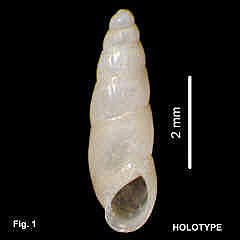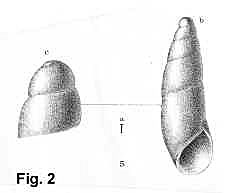|
|
EPIGRIDAE |
|
|
|
Epigrus cylindraceus (Tenison-Woods, 1878) Description: Shell of 5-7 whorls without clearly differentiated protoconch. Diameter of first whorl 300-400 microns, dome-shaped. Spire convex in outline, slightly bent away from shell axis. Upper whorls slightly inflated with slightly incised sutures, lower whorls more or less flat-sided with very slightly incised sutures. H:W ca. 3:1; last whorl 50-55% of shell height. Shell rather thick and polished, without sculpture other than very faint opisthocline growth-lines under high magnification in very fresh specimens; no varices. Aperture vertical when viewed from side; rather narrow and obliquely drop-shaped, with a narrow interior callus ledge, a sharp return where it meets the spire, a slightly-thickened outer lip without teeth, and a rounded slightly everted base. Fresher shells very pale brown and translucent; base of next earlier whorl visible through the next whorl giving the misleading appearance of a broad subsutural groove. Less fresh shells become white and opaque but still highly polished. Size: Usually 2-6 mm high, occasionally slightly larger. Distribution: Endemic to Australia: Central Queensland southwards and around southern Australia to Great Australian Bight, West Australia. Habitat: subtidal, 5-200 m Synonymy: Epigrus dissimilis (Watson, 1886) (originally genus Eulima) (NEW SYNONYM) differs only in size from E. cylindraceus. Remarks: Shells in the Australian Museum collection identified as E. dissimilis are usually 2-3 mm high with a distribution of Mackay, Queensland to southern NSW. Shells identified as E. cylindraceus are usually 3.5-5.5 mm high with a distribution of Rockhampton, Queensland southwards to Great Australian Bight, WA. However, there is fifty or so lots of unidentified specimens that are probably this species that extend the range around south-western WA and northwards to North West Cape. Fig. 1 Holotype of Epigrus cylindraceus. Five miles east of Sydney Heads, NSW (C.2469) Fig. 2 Holotype of Epigrus dissimilis. Port Jackson, 2-10 fathoms (From Watson (1886)) |
|

